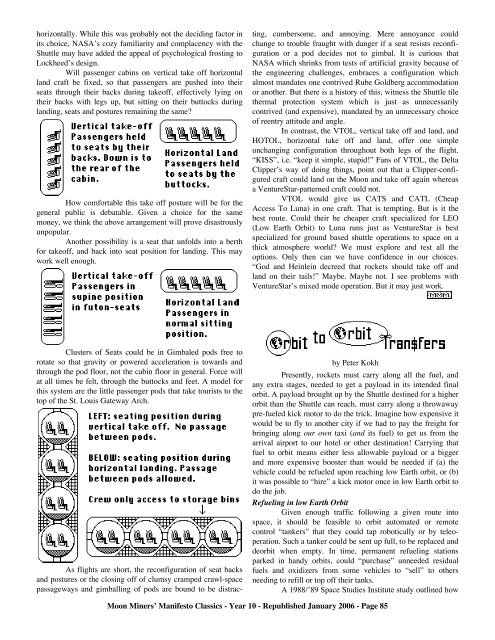MMM Classics Year 10: MMM #s 91-100 - Moon Society
MMM Classics Year 10: MMM #s 91-100 - Moon Society
MMM Classics Year 10: MMM #s 91-100 - Moon Society
You also want an ePaper? Increase the reach of your titles
YUMPU automatically turns print PDFs into web optimized ePapers that Google loves.
horizontally. While this was probably not the deciding factor in<br />
its choice, NASA’s cozy familiarity and complacency with the<br />
Shuttle may have added the appeal of psychological frosting to<br />
Lockheed’s design.<br />
Will passenger cabins on vertical take off horizontal<br />
land craft be fixed, so that passengers are pushed into their<br />
seats through their backs during takeoff, effectively lying on<br />
their backs with legs up, but sitting on their buttocks during<br />
landing, seats and postures remaining the same?<br />
How comfortable this take off posture will be for the<br />
general public is debatable. Given a choice for the same<br />
money, we think the above arrangement will prove disastrously<br />
unpopular.<br />
Another possibility is a seat that unfolds into a berth<br />
for takeoff, and back into seat position for landing. This may<br />
work well enough.<br />
Clusters of Seats could be in Gimbaled pods free to<br />
rotate so that gravity or powered acceleration is towards and<br />
through the pod floor, not the cabin floor in general. Force will<br />
at all times be felt, through the buttocks and feet. A model for<br />
this system are the little passenger pods that take tourists to the<br />
top of the St. Louis Gateway Arch.<br />
As flights are short, the reconfiguration of seat backs<br />
and postures or the closing off of clumsy cramped crawl-space<br />
passageways and gimballing of pods are bound to be distrac-<br />
ting, cumbersome, and annoying. Mere annoyance could<br />
change to trouble fraught with danger if a seat resists reconfiguration<br />
or a pod decides not to gimbal. It is curious that<br />
NASA which shrinks from tests of artificial gravity because of<br />
the engineering challenges, embraces a configuration which<br />
almost mandates one contrived Rube Goldberg accommodation<br />
or another. But there is a history of this, witness the Shuttle tile<br />
thermal protection system which is just as unnecessarily<br />
contrived (and expensive), mandated by an unnecessary choice<br />
of reentry attitude and angle.<br />
In contrast, the VTOL, vertical take off and land, and<br />
HOTOL, horizontal take off and land, offer one simple<br />
unchanging configuration throughout both legs of the flight.<br />
“KISS”, i.e. “keep it simple, stupid!” Fans of VTOL, the Delta<br />
Clipper’s way of doing things, point out that a Clipper-configured<br />
craft could land on the <strong>Moon</strong> and take off again whereas<br />
a VentureStar-patterned craft could not.<br />
VTOL would give us CATS and CATL (Cheap<br />
Access To Luna) in one craft. That is tempting. But is it the<br />
best route. Could their be cheaper craft specialized for LEO<br />
(Low Earth Orbit) to Luna runs just as VentureStar is best<br />
specialized for ground based shuttle operations to space on a<br />
thick atmosphere world? We must explore and test all the<br />
options. Only then can we have confidence in our choices.<br />
“God and Heinlein decreed that rockets should take off and<br />
land on their tails!” Maybe. Maybe not. I see problems with<br />
VentureStar’s mixed mode operation. But it may just work.<br />
by Peter Kokh<br />
Presently, rockets must carry along all the fuel, and<br />
any extra stages, needed to get a payload in its intended final<br />
orbit. A payload brought up by the Shuttle destined for a higher<br />
orbit than the Shuttle can reach, must carry along a throwaway<br />
pre-fueled kick motor to do the trick. Imagine how expensive it<br />
would be to fly to another city if we had to pay the freight for<br />
bringing along our own taxi (and its fuel) to get us from the<br />
arrival airport to our hotel or other destination! Carrying that<br />
fuel to orbit means either less allowable payload or a bigger<br />
and more expensive booster than would be needed if (a) the<br />
vehicle could be refueled upon reaching low Earth orbit, or (b)<br />
it was possible to “hire” a kick motor once in low Earth orbit to<br />
do the job.<br />
Refueling in low Earth Orbit<br />
Given enough traffic following a given route into<br />
space, it should be feasible to orbit automated or remote<br />
control “tankers” that they could tap robotically or by teleoperation.<br />
Such a tanker could be sent up full, to be replaced and<br />
deorbit when empty. In time, permanent refueling stations<br />
parked in handy orbits, could “purchase” unneeded residual<br />
fuels and oxidizers from some vehicles to “sell” to others<br />
needing to refill or top off their tanks.<br />
A 1988/’89 Space Studies Institute study outlined how<br />
<strong>Moon</strong> Miners’ Manifesto <strong>Classics</strong> - <strong>Year</strong> <strong>10</strong> - Republished January 2006 - Page 85















